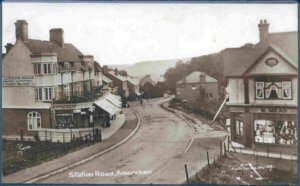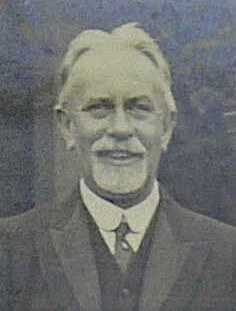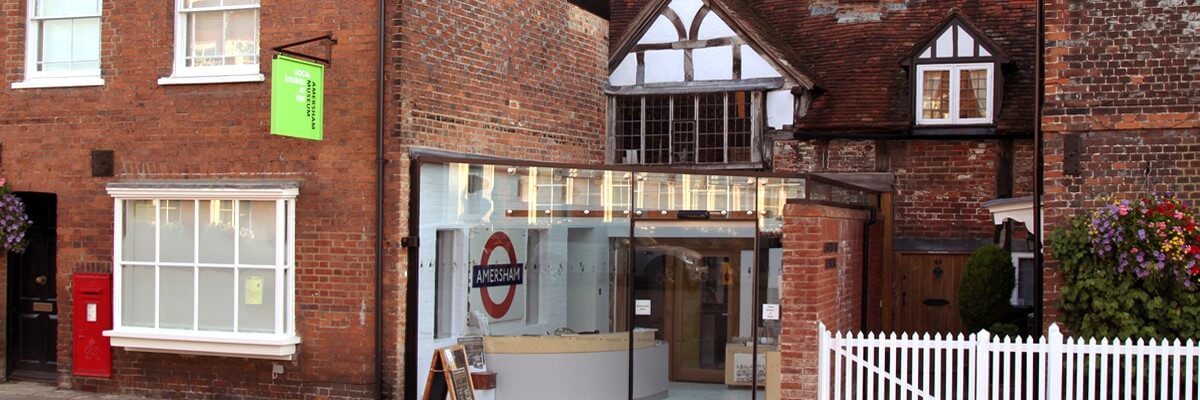
Alfred Ellis and his wife Minnie (née Anne Myra Wadsworth 1868-1956) moved to Amersham-on-the-Hill around 1906. They were both 37, had no children and had always lived in London. The Metropolitan Railway had arrived in the town in 1892 and this meant that Alfred could easily commute to his London law firm, Ellis & Co. He also recognised that there were development opportunities for an ambitious solicitor in the new town that was emerging around the station and he soon established an office in Amersham too.
It is not known when he met the young architect (John) Harold Kennard who became his close friend and associate but is possible that they already knew each other in London through work or family connections. Alfred’s father, John and his father-in-law, Russell William Wadsworth, were successful builders in London and Harold Kennard’s father, John Moir Kennard, had a thriving architect’s business there too.

Alfred helped launch Harold Kennard’s prolific career in Amersham by commissioning the first private house he built in the area. This was in The Avenue, just south of the station and was part of a Kennard and Sumner development (William Sumner was Kennard’s first partner in Amersham) which included The Parade on Station Road (the first new shops on Amersham-on-the-Hill), a terrace of houses on the opposite side of the road to the Ellis’ house and Turret House on the corner of The Avenue and Station Road. The Ellis’ house was named Fulbeck, after the village in Lincolnshire where Alfred’s father, John Ellis, was born. Set in a large garden, it is a grand Arts and Crafts house which reflects the standing of a London solicitor. Minnie’s unmarried sisters, Lillian and Eleanor also lived
at Fulbeck, as did her parents for a time, before they moved to Tunstall, Lexham Gardens. After Alfred’s death, Minnie stayed at Fulbeck until her death in January 1956.

The original Kennard drawings of the house were published in the Building News in 1906. Kennard went on to build many fine Arts and Crafts houses in Amersham-on-the-Hill and Chesham Bois. He also built shops, a parish centre and many iconic local landmarks such as Oakfield Corner and the Chesham Bois War Memorial. Alfred Ellis worked with Kennard on a number of local developments including Elm Close, which was built 1920 – 1923 using pioneering concrete blocks. Ellis and Kennard were both directors of the newly established Amersham Public Utility Society, which was part of a movement by the government to subsidize housebuilding through local authorities, public utility societies and private enterprise. The movement was an early attempt to provide affordable housing and address the shortage of housing for soldiers returning from WWI. They were also directors of the Chesham Bois Public Utility Society which planned a similar scheme which never materialised.
Alfred Ellis was born in 1868 in Shepherd’s Bush. He was the only child of John and Dessey Ellis (née Dobinson). His mother, born in Battersea, had been in service and his father, born in Lincolnshire, had worked as a carpenter, decorator and plumber before establishing his own building firm. The business prospered and the family lived comfortably in Shepherd’s Bush with a servant. Alfred was privately educated. He had a strong personal faith and loved Bible studies. He became a young leader in the Young Men’s Christian Association (YMCA) and captained their cricket team. Cricket was a lifelong passion with regular trips to Lords and the Oval where he became a member.
He was articled to a London Solicitor, Edwin Smith and joined him in a partnership on qualification in 1895. That same year he married Minnie at the Baptist Church, Vauxhall Bridge Road. He formed a later business partnership, Ellis and Collier, then Ellis & Co before forming his final company, Ellis and Fairbairn in 1919. Captain Gordon Grange Fairbairn had recently returned from the Front, having been articled at Ellis & Co before the war. As well as the Amersham office, the company’s London office was at 22 Bedford Row. They later expanded to an additional office at Millbank, and at the time of Alfred’s death in 1936 there were four partners and 36 assistants.
Ellis had a distinguished legal career and was appointed a Justice of the Peace in Buckinghamshire. He was retained as the legal advisor and London solicitor of the National Farmers Union. Agriculture became one of his specialities and he later acted on behalf of many of the newly formed marketing boards including the Hops, Pigs, Potato and Milk Marketing Boards. Perhaps most surprising was his association with the newly formed Soviet Government, following the Bolshevik revolution in Russia. He was engaged by Leonid Krasin, a Bolshevik politician and diplomat to help negotiate the first Soviet trade agreement with the British Government and to establish Britain’s recognition of the new Russian Government.
The Anglo-Soviet Trade Agreement was signed on 16 March 1921 by Robert Horne, Chancellor of the Exchequer for the British Government and Leonid Krasin, Commissar of Foreign Trade for the Russian Socialist Federal Soviet Republic. Britain was the first country to accept the Soviet Government’s offer of a trade agreement to restart the sluggish Russian economy as part of Lenin’s New Economic Policy. This ended the British blockade of Russian ports and opened a period of extensive trade. Alfred Ellis was then retained as the solicitor to the Russian Embassy in London.
Nevertheless, Alfred was most proud of his appointment as the Honorary Solicitor to the Baptist Union of Great Britain and Ireland. Both Alfred and Minnie were committed Baptists. She was a talented musician and singer and he was a gifted speaker. Both devoted these talents to the Baptist mission. When they arrived in Amersham there were no churches in the new town. On the 28th January 1907 Alfred met with four men (Messrs Deveral, Lemming, Smith & Sumner) to discuss the need for a church in Amersham-on-the- Hill. They decided to hire the Bijou Hall in Station Road for one year for Sundays and one evening a week. The first service took place the following month and was open to everybody regardless of denomination.

The congregation was soon too large for the Hall and, at the end of 1910, a Building Fund was established. Shortly afterwards some land in Sycamore Road was bought and Alfred Ellis commissioned Kennard to draw up plans for a new worship centre which was built in 1911 and extended in 1915 to seat 150 people. Two large classrooms were also added with room for 100 children in the Sunday School.
Alfred acted as the lay pastor until 1923. As well as providing services in Amersham, Alfred and Minnie regularly supported churches in all the local villages and often much further afield. He was chairman of the Lay Preachers’ Federation and a strong supporter of women lay preachers.
He resigned his position of president and leader of the Amersham fellowship so that a full-time pastor could be appointed. In July 1924, the Rev Adam Waugh took up the position and the fellowship formally became a church, known as the Amersham Free Church. Although he had retired from his church offices, Alfred Ellis didn’t stop working for the Church. In 1931 he was elected Vice President of the Baptist Union and in 1932, President. According to his obituary in the Bucks Examiner he was honoured by this appointment and was quoted as saying, “I think that, more precious than the honour, is the love and confidence of those who have called me to this office. In conferring this honour upon me you have also conferred an honour upon that splendid body of lay-preachers who are doing such magnificent work”.
After his death in 1936 a Memorial Fund was set up for a new church building on land on Woodside Road which Alfred had helped the church buy in 1920. 42 years later the new church was completed on Woodside Road and Alfred Ellis was remembered as the founder of the Church with a Memorial Stone in the new building.

According to the obituary his funeral service at Amersham Free Church and then the internment at Amersham Churchyard was an extraordinary spectacle with hundreds of people in attendance from all the different aspects of his life. Dr Carlile of Folkestone delivered this tribute to his friend, “he was an example of the real harmony between true faith and good works. A clear thinker, with a trained mind accustomed to sift and weigh evidence. In private life as in public work there was the calm dignity of the Christian gentleman. With a happy sense of humour there was combined a keen appreciation of the feelings of others. He delighted in a humorous story, but I never heard him make a joke that left a wound in the memory. Mr Ellis was naturally an approachable man. It was easy for him to enter into the experience of others, patiently to listen to their cares and share in hearing their burdens. He was one who had the gift of making goodness attractive”.
Sources:
Bucks Examiner 4 September 1936 Obituary of Alfred Ellis
Ancestry.co.uk
https://en.wikipedia.org/wiki/Anglo-Soviet_Trade_Agreement
http://www.amershamfreechurch.org.uk/history/191424/

